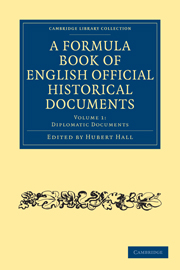Book contents
- Frontmatter
- PREFACE
- Contents
- ABBREVIATIONS USED IN THE REFERENCES, ETC. OF THIS WORK
- I INSTRUMENTS UNDER THE GREAT SEAL
- II INSTRUMENTS UNDER THE SMALLER SEALS
- 1 WRITS AND LETTERS MISSIVE
- 2 WARRANTS FOR THE ISSUE OF THE GREAT SEAL
- 3 DEPARTMENTAL WARRANTS FOR THE ISSUE OF THE GREAT SEAL
- III DEPARTMENTAL INSTRUMENTS
- IV SEMI-OFFICIAL INSTRUMENTS
- V STATE PAPERS AND DEPARTMENTAL INSTRUMENTS
3 - DEPARTMENTAL WARRANTS FOR THE ISSUE OF THE GREAT SEAL
Published online by Cambridge University Press: 05 October 2010
- Frontmatter
- PREFACE
- Contents
- ABBREVIATIONS USED IN THE REFERENCES, ETC. OF THIS WORK
- I INSTRUMENTS UNDER THE GREAT SEAL
- II INSTRUMENTS UNDER THE SMALLER SEALS
- 1 WRITS AND LETTERS MISSIVE
- 2 WARRANTS FOR THE ISSUE OF THE GREAT SEAL
- 3 DEPARTMENTAL WARRANTS FOR THE ISSUE OF THE GREAT SEAL
- III DEPARTMENTAL INSTRUMENTS
- IV SEMI-OFFICIAL INSTRUMENTS
- V STATE PAPERS AND DEPARTMENTAL INSTRUMENTS
Summary
Warrants of a Departmental nature seem to have been filed amongst the Chancery ‘Warrants for Issue,’ and from an early period were accepted as a sufficient authority for the issue of Letters Patent which are stated to have been ‘procured’ by the respective Household officers (per billant Thesaurarii Anglié, etc.).
Thus a Warrant might be submitted under the seal of the Lord Treasurer to the Lord Chancellor for the appointment of a revenue officer (No. 129), being presumably a matter within the jurisdiction of the former official. The personal seal was affixed on the face of the Warrant ‘en placard,’ and was sometimes secured by a slit in the parchment or by other devices. The Privy Seal was affixed on the dorse of the Warrant.
Similarly, Departmental Warrants were issued by the Treasurer of the Household to the Clerk of the Crown in Chancery (No. 130) in favour of a royal purveyor, to whom a Writ of Assistance had been granted since the 13th century. It will be seen that the language of this early Warrant is French, and the form of execution is noticeable. The later Writ of Assistance printed below (No. 131) is in Latin and is probably a draft submitted for expedition by the Chancery.
Amongst the earliest of such Departmental Warrants are those issued by the Chief Butler of England for the appointment of deputies to collect the dues comprised under the head of Butlerage (No. 128), and similar ‘deputations’ were made” from an early date by the King's Ulnager (No. 132).
- Type
- Chapter
- Information
- A Formula Book of English Official Historical Documents , pp. 119 - 121Publisher: Cambridge University PressPrint publication year: 2010First published in: 1908



